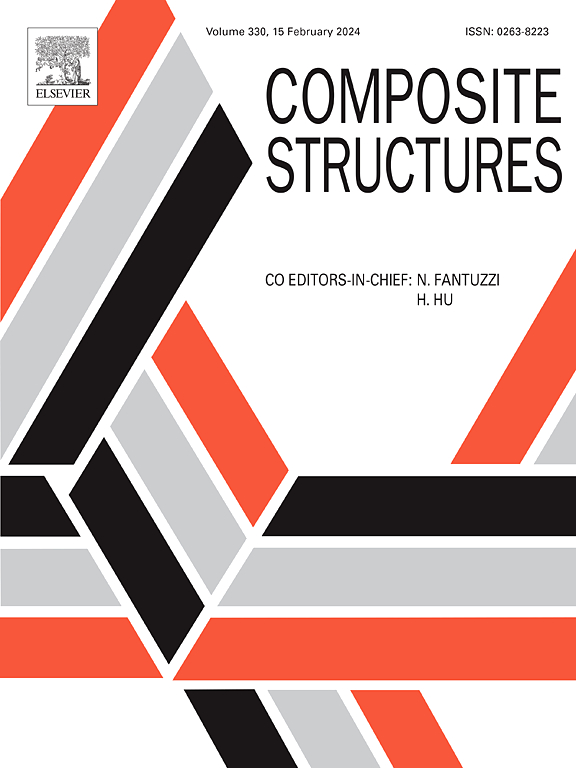GFRP单螺栓双搭接接头的剪切破坏:试验研究和基于可靠性的规范标定
IF 7.1
2区 材料科学
Q1 MATERIALS SCIENCE, COMPOSITES
引用次数: 0
摘要
本文的目的有两个:展示和讨论(i)对玻璃纤维增强聚合物(GFRP)单螺栓双接连接容易发生剪切破坏的短期力学行为的实验研究,以及(ii)基于可靠性的规范校准(RBCC)程序,以确定在CEN/TS 19101:2022中规定的相应设计规则中采用的最佳部分安全系数:“纤维-聚合物复合材料结构的设计”。由于文献中缺乏完整的剪切破坏实验数据,里斯本大学进行了一项广泛的实验计划,包括主要通过拉挤和真空辅助树脂转移模塑(VARTM)制造的GFRP样品。详细描述了实验活动,包括材料表征测试,双搭接连接测试,以及相应的主要结果(载荷-位移平衡路径,失效模式和载荷)。然后,基于结构安全联合委员会方法的严格RBCC方法应用于CEN/TS 19101:2022采用的阻力模型,包括材料,载荷,几何和阻力模型的可变性。所有试件均表现出典型的剪切破坏,CEN/TS 19101:2022电阻模型的变异系数相对较低,为17%。规范校准程序表明,电阻模型部分安全系数(γRd)为1.45或1.50,取决于所使用的惩罚函数的严格程度,需要满足结构欧洲规范规定的最终极限状态(ULS)的安全水平。此外,还提出了一种适用于ULS螺栓连接的新型电阻形式。本文章由计算机程序翻译,如有差异,请以英文原文为准。
Shear-out failure of GFRP single-bolted double-lap connections: Experimental investigation and reliability-based code calibration
The objective of this paper is two-fold: to present and discuss (i) an experimental investigation on the short-term mechanical behaviour of glass fibre-reinforced polymer (GFRP) single-bolted double-lap connections prone to shear-out failure, and (ii) a reliability-based code calibration (RBCC) procedure to determine optimal partial safety factors to be employed in the corresponding design rules prescribed in CEN/TS 19101:2022: “Design of Fiber-Polymer Composite Structures”. Due to the lack of a complete set of experimental data available in the literature exhibiting shear-out failure, an extensive experimental program was conducted at the University of Lisbon, comprising GFRP specimens manufactured predominantly by pultrusion and also by vacuum-assisted resin transfer moulding (VARTM). A detailed description of the experimental campaign is presented, covering material characterization tests, double-lap connection tests, and the corresponding main results (load–displacement equilibrium paths, failure modes and loads). A rigorous RBCC approach, based on the Joint Committee on Structural Safety methodology, is then applied to the resistance model adopted in CEN/TS 19101:2022, incorporating material, load, geometrical, and resistance model variability. All specimens exhibited typical shear-out failures, and the CEN/TS 19101:2022 resistance model exhibited a relatively low coefficient of variation of 17 %. The code calibration procedure showed that a resistance model partial safety factor (γRd) of 1.45 or 1.50, depending on the stringency of the penalty function used, are required to meet the safety levels prescribed by the Structural Eurocodes for the ultimate limit state (ULS) under investigation. In addition, a new and advantageous resistance format for ULS bolted connections is proposed.
求助全文
通过发布文献求助,成功后即可免费获取论文全文。
去求助
来源期刊

Composite Structures
工程技术-材料科学:复合
CiteScore
12.00
自引率
12.70%
发文量
1246
审稿时长
78 days
期刊介绍:
The past few decades have seen outstanding advances in the use of composite materials in structural applications. There can be little doubt that, within engineering circles, composites have revolutionised traditional design concepts and made possible an unparalleled range of new and exciting possibilities as viable materials for construction. Composite Structures, an International Journal, disseminates knowledge between users, manufacturers, designers and researchers involved in structures or structural components manufactured using composite materials.
The journal publishes papers which contribute to knowledge in the use of composite materials in engineering structures. Papers deal with design, research and development studies, experimental investigations, theoretical analysis and fabrication techniques relevant to the application of composites in load-bearing components for assemblies, ranging from individual components such as plates and shells to complete composite structures.
 求助内容:
求助内容: 应助结果提醒方式:
应助结果提醒方式:


